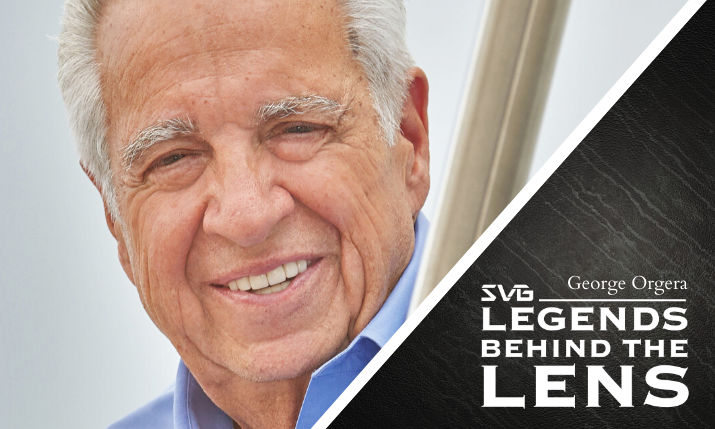Legends Behind the Lens: George Orgera
The remote television visionary shaped a global live production industry
Story Highlights

The story of American sports television is engrained in the history of this nation, rising on the achievements of countless incredible men and women who never once appeared on our screens. During this pause in live sports, SVG is proud to present a celebration of this great industry. Legends Behind the Lens is a look at how we got here seen through the people who willed it to be. Each weekday, we will share with you the story of a person whose impact on the sports-television industry is indelible.
Legends Behind the Lens is presented in association with the Sports Broadcasting Hall of Fame and the SVG Sports Broadcasting Fund. In these trying times — with so many video-production professionals out of work — we hope that you will consider (if you are able) donating to the Sports Broadcasting Fund. Do so by visiting sportsbroadcastfund.org.
___________________________
By Ken Kerschbaumer
George Orgera, founding CEO and president of F&F Productions, remains a man of vision and the driving force behind a company whose success story is rooted in a commitment to engineering excellence backed by a team of veteran broadcasters who, over the years, have traveled its remote-television-production units to virtually every country in the Western Hemisphere.
“George is an icon and an original in our industry,” says Chris Calcinari, VP, remote operations, ESPN. “His personality is larger than life, and his word is something that you can count on. All of us at ESPN have been very fortunate to work with him, share laughs with him, and learn from him. His legacy is simple: true gentleman, fun to be around, smart and fair businessman that cares deeply about his clients.”
Orgera’s impact on the industry began in 1973, when he was chief engineer at WTOG-TV St. Petersburg, FL. He often found himself huddled with his technicians inside a Chevy cube van while managing a dual role when he assumed the duties of overseeing the station’s remote TV productions.
With a vision of growth, Orgera was convinced that there were opportunities for a sophisticated mobile TV-production service.
In 1974, he sold his boss, James Dowdle, on the idea of expansion, added another camera to the cube van, and secured weekly production of Championship Wrestling From Florida and other events around the Tampa Bay area. From there, Orgera put his creative thinking, sales experience, and engineering talents to work and began developing what would later become F&F Productions.
In 1976, WTOG experienced significant expansion. Orgera began growing the fleet by offering the best broadcast gear of its day in roomy surroundings aboard the Barth. With room for six people, the 28-ft. “go anywhere” unit featured four cameras, a 2M/E production switcher, 1-in. tape machines with slo-mo controllers, a custom 16x4x1 audio console, and two-channel graphic generators. The Barth was a perfect fit for the North American Soccer League and its live broadcasts for the Tampa Bay Rowdies and the Fort Lauderdale Strikers.
“George has been a spirit of innovation, fairness, and industry diplomacy. He has put an indelible mark on the mobile-unit business through his vision and demeanor that is truly far-reaching in sports television.” – Mike Davies, SVP, technical and field operations, Fox Sports
Orgera’s track record and well-positioned proposal allowed him to successfully persuade his colleagues at Hubbard Broadcasting to create a new division. In 1979, F&F was spun off as a corporation and leaped into the fledgling independent-remote-broadcast industry, commissioning the first of its flagship mobile production units.
In 1981, Orgera debuted the first of F&F’s signature GT (rumored to stand for “Great Trucks, Great Team”) series. The GTX-1, a 48-ft. mobile production facility, was put on display for examination by tens of thousands of broadcasters attending the NAB Show from all over the world.
Orgera’s business success has been matched by technical innovation. He designed and built the first Ku-band ENG truck, which is now on display at the Newseum in Washington, D.C.
Orgera also contributed to the original design of an interruptible RTS system that would set a new communications-system standard still used universally throughout the industry.
Over the years, F&F has been a mainstay at events like The Masters, CBS college football, and the US Open tennis tournament. And there have been plenty of special moments, including in 1984 when an F&F truck covering the Baseball World Cup was the first American vehicle since 1958 to traverse Cuba. In addition, in 1985, an F&F mobile production unit was the only American remote facility to support the Live Aid concert in Philadelphia.
“Through the years I have known him, George has been a spirit of innovation, fairness, and industry diplomacy,” says Mike Davies, SVP, technical and field operations, Fox Sports. “From his first ‘great truck’ to the newer ones that handle some of the biggest shows in the country, he has put an indelible mark on the mobile-unit business through his vision and demeanor that is truly far-reaching in sports television.”
The video in this profile was originally produced in 2014. For more on the life and career of this industry legend, visit their profile at the Sports Broadcasting Hall of Fame.
